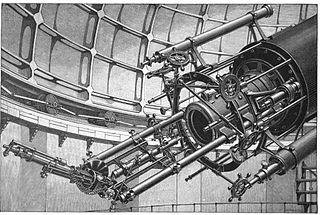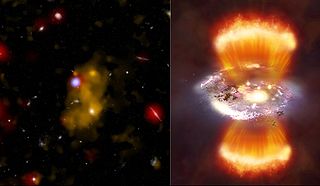
A quasar is an extremely luminous active galactic nucleus (AGN). It is sometimes known as a quasi-stellar object, abbreviated QSO. The emission from an AGN is powered by a supermassive black hole with a mass ranging from millions to tens of billions of solar masses, surrounded by a gaseous accretion disc. Gas in the disc falling towards the black hole heats up and releases energy in the form of electromagnetic radiation. The radiant energy of quasars is enormous; the most powerful quasars have luminosities thousands of times greater than that of a galaxy such as the Milky Way. Quasars are usually categorized as a subclass of the more general category of AGN. The redshifts of quasars are of cosmological origin.

In physics, a redshift is an increase in the wavelength, and corresponding decrease in the frequency and photon energy, of electromagnetic radiation. The opposite change, a decrease in wavelength and increase in frequency and energy, is known as a blueshift, or negative redshift. The terms derive from the colours red and blue which form the extremes of the visible light spectrum. The main causes of electromagnetic redshift in astronomy and cosmology are the relative motions of radiation sources, which give rise to the relativistic Doppler effect, and gravitational potentials, which gravitationally redshift escaping radiation. All sufficiently distant light sources show cosmological redshift corresponding to recession speeds proportional to their distances from Earth, a fact known as Hubble's law that implies the universe is expanding.
Timeline of knowledge about the interstellar medium and intergalactic medium:

Astronomical spectroscopy is the study of astronomy using the techniques of spectroscopy to measure the spectrum of electromagnetic radiation, including visible light, ultraviolet, X-ray, infrared and radio waves that radiate from stars and other celestial objects. A stellar spectrum can reveal many properties of stars, such as their chemical composition, temperature, density, mass, distance and luminosity. Spectroscopy can show the velocity of motion towards or away from the observer by measuring the Doppler shift. Spectroscopy is also used to study the physical properties of many other types of celestial objects such as planets, nebulae, galaxies, and active galactic nuclei.
Lyman-alpha, typically denoted by Ly-α, is a spectral line of hydrogen (or, more generally, of any one-electron atom) in the Lyman series. It is emitted when the atomic electron transitions from an n = 2 orbital to the ground state (n = 1), where n is the principal quantum number. In hydrogen, its wavelength of 1215.67 angstroms (121.567 nm or 1.21567×10−7 m), corresponding to a frequency of about 2.47×1015 Hz, places Lyman-alpha in the ultraviolet (UV) part of the electromagnetic spectrum. More specifically, Ly-α lies in vacuum UV (VUV), characterized by a strong absorption in the air.
The Balmer series, or Balmer lines in atomic physics, is one of a set of six named series describing the spectral line emissions of the hydrogen atom. The Balmer series is calculated using the Balmer formula, an empirical equation discovered by Johann Balmer in 1885.

In the fields of Big Bang theory and cosmology, reionization is the process that caused electrically neutral atoms in the universe to reionize after the lapse of the "dark ages".

The hydrogen line, 21 centimeter line, or H I line is a spectral line that is created by a change in the energy state of solitary, electrically neutral hydrogen atoms. It is produced by a spin-flip transition, which means the direction of the electron's spin is reversed relative to the spin of the proton. This is a quantum state change between the two hyperfine levels of the hydrogen 1 s ground state. The electromagnetic radiation producing this line has a frequency of 1420.405751768(2) MHz (1.42 GHz), which is equivalent to a wavelength of 21.106114054160(30) cm in a vacuum. According to the Planck–Einstein relation E = hν, the photon emitted by this transition has an energy of 5.8743261841116(81) μeV [9.411708152678(13)×10−25 J]. The constant of proportionality, h, is known as the Planck constant.
In astronomical spectroscopy, the Gunn–Peterson trough is a feature of the spectra of quasars due to the presence of neutral hydrogen in the Intergalactic medium (IGM). The trough is characterized by suppression of electromagnetic emission from the quasar at wavelengths less than that of the Lyman-alpha line at the redshift of the emitted light. This effect was originally predicted in 1965 by James E. Gunn and Bruce Peterson.

The emission spectrum of atomic hydrogen has been divided into a number of spectral series, with wavelengths given by the Rydberg formula. These observed spectral lines are due to the electron making transitions between two energy levels in an atom. The classification of the series by the Rydberg formula was important in the development of quantum mechanics. The spectral series are important in astronomical spectroscopy for detecting the presence of hydrogen and calculating red shifts.

The Cosmic Origins Spectrograph (COS) is a science instrument that was installed on the Hubble Space Telescope during Servicing Mission 4 (STS-125) in May 2009. It is designed for ultraviolet (90–320 nm) spectroscopy of faint point sources with a resolving power of ≈1,550–24,000. Science goals include the study of the origins of large scale structure in the universe, the formation and evolution of galaxies, and the origin of stellar and planetary systems and the cold interstellar medium. COS was developed and built by the Center for Astrophysics and Space Astronomy (CASA-ARL) at the University of Colorado at Boulder and the Ball Aerospace and Technologies Corporation in Boulder, Colorado.

Lyman continuum photons, shortened to Ly continuum photons or Lyc photons, are the photons emitted from stars or active galactic nuclei at photon energies above the Lyman limit. Hydrogen is ionized by absorbing LyC. Working from Victor Schumann's discovery of ultraviolet light, from 1906 to 1914, Theodore Lyman observed that atomic hydrogen absorbs light only at specific frequencies and the Lyman series is thus named after him. All the wavelengths in the Lyman series are in the ultraviolet band. This quantized absorption behavior occurs only up to an energy limit, known as the ionization energy. In the case of neutral atomic hydrogen, the minimum ionization energy is equal to the Lyman limit, where the photon has enough energy to completely ionize the atom, resulting in a free proton and a free electron. Above this energy, all wavelengths of light may be absorbed. This forms a continuum in the energy spectrum; the spectrum is continuous rather than composed of many discrete lines, which are seen at lower energies.

A Lyman-alpha emitter (LAE) is a type of distant galaxy that emits Lyman-alpha radiation from neutral hydrogen.
In physics, the proton-to-electron mass ratio is the rest mass of the proton divided by that of the electron, a dimensionless quantity, namely:
Damped Lyman alpha systems or Damped Lyman alpha absorption systems is a term used by astronomers for concentrations of neutral hydrogen gas that are detected in the spectra of quasars – a class of distant Active Galactic Nuclei. They are defined to be systems where the column density (density projected along the line of sight to the quasar) of hydrogen is larger than 2 x 1020 atoms/cm2.
Wouthuysen–Field coupling, or the Wouthuysen–Field effect, is a mechanism that couples the excitation temperature, also called the spin temperature, of neutral hydrogen to Lyman-alpha radiation. This coupling plays a role in producing a difference in the temperature of neutral hydrogen and the cosmic microwave background at the end of the Dark Ages and the beginning of the epoch of reionization. It is named for Siegfried Adolf Wouthuysen and George B. Field.
In cosmology, the missing baryon problem is an observed discrepancy between the amount of baryonic matter detected from shortly after the Big Bang and from more recent epochs. Observations of the cosmic microwave background and Big Bang nucleosynthesis studies have set constraints on the abundance of baryons in the early universe, finding that baryonic matter accounts for approximately 4.8% of the energy contents of the Universe. At the same time, a census of baryons in the recent observable universe has found that observed baryonic matter accounts for less than half of that amount. This discrepancy is commonly known as the missing baryon problem. The missing baryon problem is different from the dark matter problem, which is non-baryonic in nature.

TON 618 is a hyperluminous, broad-absorption-line, radio-loud quasar and Lyman-alpha blob located near the border of the constellations Canes Venatici and Coma Berenices, with the projected comoving distance of approximately 18.2 billion light-years from Earth. It possesses one of the most massive black holes ever found, at 40.7 billion M☉.

Peter John Young was a British astrophysicist, who made major contributions in theory and observation to extragalactic astronomy and cosmology. During five years at the California Institute of Technology in 1976-1981 he carried out foundational research, including the discovery of the intergalactic medium; the detection of a supermassive black hole in the galaxy M87; detecting the optical counterpart to the first gravitational lens; developing the theory of gravitational microlensing.
Bruce Alrick Peterson is a cosmologist based at Mount Stromlo Observatory of the Australian National University. Peterson and James Gunn predicted the Gunn–Peterson trough, the absorption effect of neutral hydrogen on the spectra of quasars. His research includes studies of quasars, dark matter and the large-scale structure of the unvierse.












